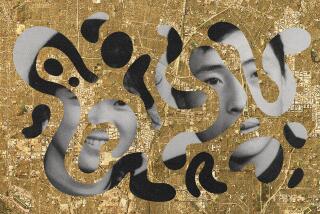Descendants of Pioneer Families to Go Online
- Share via
For six decades, descendants of Los Angeles pioneers have met each year to remember their roots and to ruminate over how the place has changed since the old days.
But Thursday, members of the group called First Century Families had something new to celebrate as they gathered for their 60th annual luncheon.
Historians and officials from USC disclosed that they are creating an archival research center that will use computers to catalog historic papers and photographs that generations of old-timers have squirreled away in attics and garages.
Researchers, scholars and the curious around the world will eventually be able to peruse digitalized facsimiles of diaries, letters and business records that tell the personal story of the people who built Los Angeles.
“We’re interested in primary source material that tells how these families created a world-class city so rapidly,” said historian Kevin Starr, who along with serving as California’s state librarian will be USC’s faculty consultant for what the university has labeled its Historical Families Initiative. “We’re interested in family alliances, marriage patterns.”
When it comes to fleshing out the past, Starr added, “you have to go back to the 19th century to get the DNA of this city.”
The electronic archives will also document early rancho families and early African American and Asian American families.
“We have an important history that should be shared,” said Christine Glogow, an assistant vice president at USC.
That sentiment drew nods of agreement from the crowd of about 300 First Century Families members at the Regent Beverly Wilshire Hotel in Beverly Hills.
Some descendants of pioneer families have struggled with the disposition of “old letters, old family treasures,” said Barbara Osthaus, a Hancock Park resident whose family has been in Los Angeles since the Lincoln presidency. She is the chairwoman of First Century Families.
The option of Internet access is intriguing, said Ynez Viole O’Neill, a Central City resident whose Los Angeles roots reach back to 1858. “It’s a wonderful idea. You don’t want things sitting on a shelf where nobody sees them,” O’Neill said.
Westside resident Julia Stearns Dockweiler said she has saved “boxes of things” relating to her family’s past--which dates to 1868, when her grandfather arrived in Los Angeles.
Eighty-one-year-old Connie Clark Blanford of Pacific Palisades said she will donate to the archives. Her grandfather and uncle, Eli Clark and Moses Sherman, helped launch the old Red Car trolley system.
Blanford’s daughter, Mary Martin, and granddaughter Melissa Russart, also of Pacific Palisades, are all for it.
Russart, 18, said she was stunned to see Sherman’s name in an ecology book she read while attending school in Michigan. “I’d be proud to share my family’s history,” Russart said.
Helen Amestoy--whose family members arrived in Los Angeles in 1851 from the Basque area of France--said she and her husband, Michel Amestoy of West Los Angeles, plan to donate their family papers to the Los Encinos State Historic Park in Encino, which was part of Domingo Amestoy’s original farm. But she said they will consider sending copies to the Historic Families Initiative.
Amestoy contributions to Los Angeles include the first elevator, the first horse-drawn trolley and--with great-uncle Domingo Gless--the first automobile in the city, according to Elizabeth Baur Springer, who is Michel Amestoy’s second cousin.
“Putting it on the Internet is fine. I’m sure there are some family skeletons, but that’s OK too. That’s what makes us all so interesting,” Springer said.
Others at Thursday’s luncheon were more cautious. Dr. Lloyd Mills, whose grandfather Davis Richardson arrived in the late 1880s, said he values his family’s privacy along with its past.
“Most of us prefer to withdraw from the intrusive world,” said Mills, a former medical school professor from Bel-Air. “The walls are getting bigger and bigger.”
More to Read
Sign up for Essential California
The most important California stories and recommendations in your inbox every morning.
You may occasionally receive promotional content from the Los Angeles Times.














